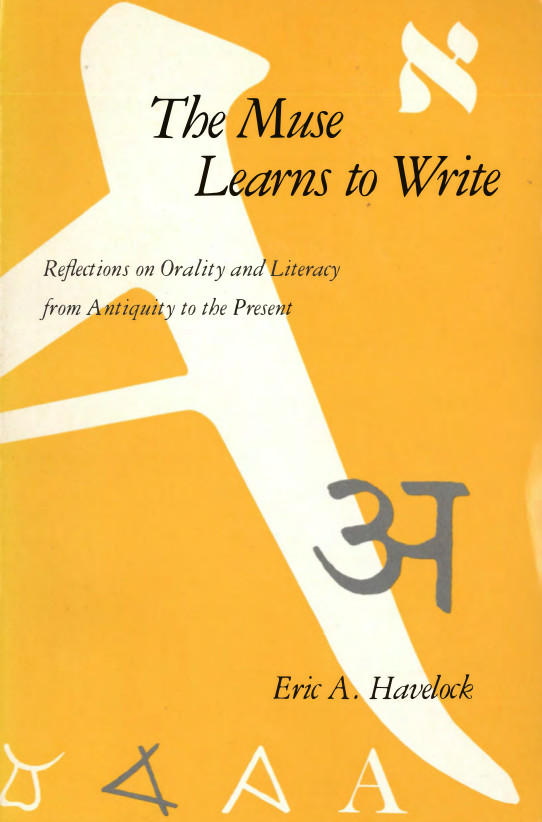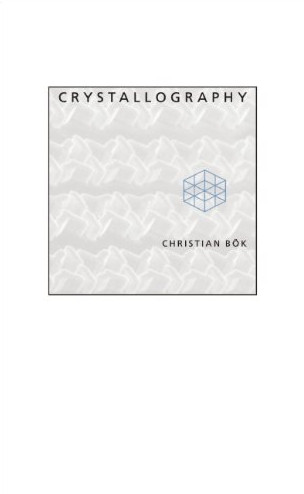Eric A. Havelock: The Muse Learns to Write: Reflections on Orality and Literacy from Antiquity to the Present (1986–) [EN, ES]
Filed under book | Tags: · greece, literacy, orality, rhetoric, writing

“When oral culture becomes literate, in what way does human consciousness itself change? And how does the new form of communication affect the content and meaning of texts? In this book, one of the most original and penetrating thinkers in Greek studies describes the transformation from orality to literacy in classical times and reflects upon its continued meaning for us today.”
Publisher Yale University Press, 1986
ISBN 0300037414, 9780300037418
144 pages
via x
Reviews: Richard Leo Enos (Rhetoric Society Quarterly 1987), T. J. Winnifrith (Classical Review 1988), Elizabeth Duke (Phil & Lit 1990), J.M. Foley (Choice, n.d.).
The Muse Learns to Write (English, 8 MB)
La musa aprende e escribir (Spanish, trans. Luis Bredlow Wenda, 1996, 3 MB)
Christian Bök: Crystallography (1994/2003)
Filed under poetry | Tags: · concrete poetry, language, pataphysics, poetry, science, visual poetry

“Crystallography’ means the study of crystals, but also, taken literally, ‘lucid writing.’ The book exists in the intersection of poetry and science, exploring the relationship between language and crystals – looking at language as a crystal, a space in which the chaos of individual parts align to expose a perfect formation of structure. As Bök himself says, ‘a word is a bit of crystal in formation,’ suggesting there is a space in which words, like crystals, can resonate pure form.”
First edition published 1994
Second edition, revised
Publisher Coach House Books, Toronto, 2003
ISBN 1552451194
157 pages
via ExP
Reviews: Darren Wershler-Henry (2001), Adam Golaski (Open Letters Monthly 2007), Ian Rae (Canadian Literature 2011).
Commentary: Nathan Brown (2004), James Elkins (2014).
PDF (removed on 2016-8-16 upon request of the publisher)
Comment (0)Your Private Sky: R. Buckminster Fuller: The Art of Design Science (1999)
Filed under book | Tags: · architecture, design, design research, earth, engineering, invention, science, technology

“‘Bucky’ was one of the most revolutionary technological visionaries of this century. As an architect, engineer, entrepreneur, poet, he was a quintessentially American, self-made man. But he was also an outsider: a technologist with a poet’s imagination who already developed theories of environmental control in the thirties (“more with less”) and anticipated the globalization of our planet (“think global – act local”).
This visual reader documents and examines Fuller’s theories, ideas, designs, and projects. It also takes an analytical look at his ideology of technology as the panacea. With numerous illustrations, many published here for the first time, as well as texts by Fuller and the editors.
The publication presents Buckminster Fuller’s creations as a dazzling expression of this unconditionally optimistic technocrat whose vision of driverless Spaceship Earth led him to examine the principles of maximizing effects in the most diverse sectors of design and construction.”
Edited by Joachim Krausse and Claude Lichtenstein
Translated by Steven Lindberg and Julia Thorson
Publisher Lars Müller, Baden, 1999
ISBN 3907044886, 9783907044889
528 pages
via ExP
Review: John Martinson (Geographical Review 2001).
PDF (no OCR, 68 MB)
Comment (0)
